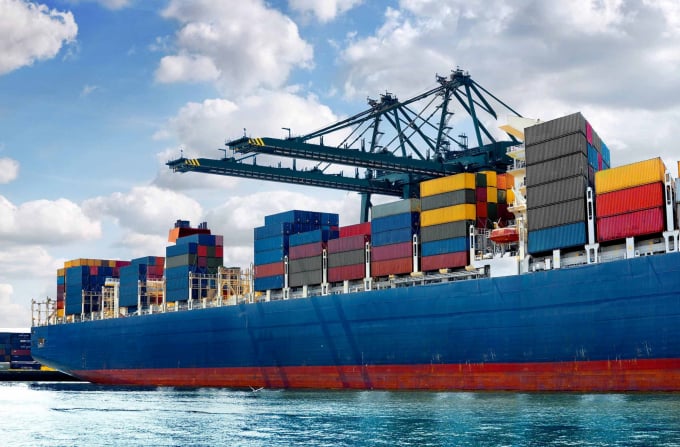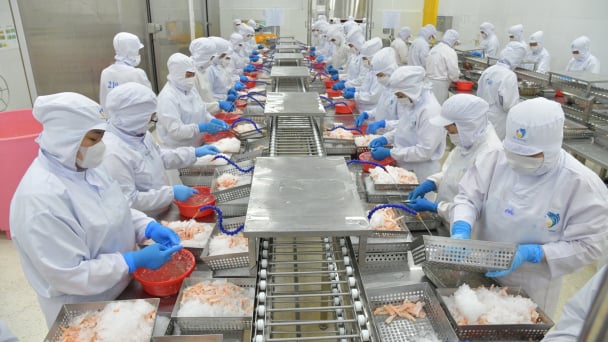September 6, 2025 | 13:03 GMT +7
September 6, 2025 | 13:03 GMT +7
Hotline: 0913.378.918
September 6, 2025 | 13:03 GMT +7
Hotline: 0913.378.918

Shipping lines reduce capacity as demand increases, causing sea freight rates to rise. Photo: TL.
According to the Vietnam Industry and Trade Information Center (Ministry of Industry and Trade), the demand for shipping plummeted in spring 2020, when world countries blockaded to prevent the spread of Covid- 19.
Then demand rose again in late summer 2020 as consumers ramped up their online shopping, from sports equipment to new video games and furniture, especially in Europe and North America.
However, when the demand for shopping increased again, the shipping lines reduced shipping capacity. According to Gordon Downes, CEO of the New York Shipping Exchange, while demand rebounded in the second half of 2020, ocean carriers were canceling inefficient shipments. As a result, shipping lines and ports were seriously stuck, while freight rates rose to record levels. In the future, carriers may continue to cancel high-risk or ineffective shipments to ensure their profits.
Earlier this year, many shipping lines continued to cancel ships from Asia to Europe. For example, the partners of the 2M Maersk Alliance and the Mediterranean Shipping Company announced the cancellation of four Eurasian trips during the New Year's Eve.
Many international market experts believe that it is unusual to reduce capacity of shipping lines while demand increases. “Big carriers have a tradition of pursuing revenue at all costs,” said Joshua Brogan, Vice President of strategic operations at AT Kearney, a global consulting firm. “They will want to increase capacity as demand increases so as to gain market share. Currently, however, the lines do not seem to increase capacity, causing demand to exceed supply and freight rates to skyrocket”.
According to international experts, lack of empty containers as well as warehouses for storage due to congestion at ports since the end of 2020 is the most recent sign of a global trade system going so tense.
Sea freight rates of some international shipping companies have increased so high, especially after October 2020, that profits of shippers are falling to a very low level. Cost of freight increased while the overall cost remained the same, putting pressure on companies. As a result, many companies will face bankruptcy this year.
The Covid-19 pandemic created seismic waves in global trade and sea shipments around the world. However, carriers quickly reduced volume and redundancy due to weaker demand, thereby supporting freight rates. This is partly due to the recent merge of three important shipping alliances: the 2M Alliance, the Oceanic Alliance and the High Efficiency Transport Alliance (THE). According to a report of S&P Global, the three alliances currently account for more than 80% of the global shipping market.
The rapid increase in shipping rates may cause businesses to reconsider agreements with transport service providers. Accordingly, more frequent negotiations with carriers and forwarders will become more common under “new normal” conditions.
The pricing based on a set of indicators for the maritime industry is also being applied more widely. Today, there are more indicators for goods owners to manage and keep contract rates. In addition, many large corporations are considering restructuring the supply chain... in order to reduce the number of sea shipments.

(VAN) Participating in the A80 Exhibition, Thuyloi University showcased its booth featuring outstanding research achievements in water resources and irrigation.

(VAN) UNDP stays ready to continue working alongside Vietnam in advancing its NDC 3.0, EPR mechanism, and the Green Carbon Partnership Program, while broadening cooperation on climate response and green development.

(VAN) Science and technology, along with new-generation FTAs, serve as a dual driving force, helping Vietnam’s seafood industry consolidate sustainable competitiveness and accelerate international integration.

(VAN) On the afternoon of September 4, the 'Vietnam–Japan Public–Private Agricultural Cooperation Dialogue' forum was held in Tokyo, Japan.

(VAN) The two ministers affirmed that, in a world facing numerous challenges, Vietnam–Japan agricultural cooperation is more strategically significant than ever.

(VAN) Planting area codes have become a ‘passport’ enabling Tuyen Quang’s agricultural products to cross borders and conquer demanding markets worldwide.
/2025/09/04/0437-2-145633_799.jpg)
(VAN) Deputy Minister Phung Duc Tien has directed drastic measures to address institutional, planning, and market bottlenecks in order to meet growth targets for the remaining four months of the year.